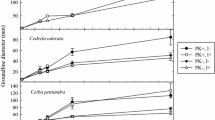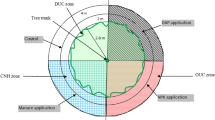Abstract
Wild leek (Allium tricoccum) is an edible spring ephemeral of the eastern deciduous forests of North America that takes advantage of the short period of high light conditions between snowmelt and canopy closure to accumulate the carbon required to complete its annual growth and seed production. In Québec (Canada), this slow-growing species has been subjected to great harvesting pressure, which forced the provincial government to ban commercial harvest and sales in 1995. An illegal market has since developed and the plant is still under threat. Conservation of existing natural populations might be possible through commercial production of wild leek. To investigate this possibility, we set up plots in four sugar maple forest stands where different organic fertilizer and gypsum (0 or 3,000 kg ha−1) applications were tested, together with two wild leek varieties, and bulb planting season. The two varieties, tricoccum and burdickii, despite morphological differences, are both suitable for cultivation. Planting bulbs in the spring seems more advantageous than in autumn, but these results will need to be confirmed. Fertilized plants exhibited better growth the year following transplantation than did non-fertilized plants. Belowground:aboveground biomass ratios indicated that plants receiving more fertilizer produced larger bulbs, but leaf size did not differ statistically. According to leaf nutrient analysis, fertilizers would need to be applied each year, whereas gypsum (as a calcium source) can be applied less frequently. Our results indicated a high potential for wild leek as a forest crop, at least when the bulbs are planted.






Similar content being viewed by others
References
Brouillet L, Coursol F, Favreau M, Anions M, Bélisle P, Desmet P (2010) VASCAN, the database of vascular plants of Canada. http://data.canadensys.net/vascan/. Accessed 15 Sep 2011
Buwalda JG, Freeman RE (1987) Effects of nitrogen fertilisers on growth and yield of potato (Solanum tuberosum L. ‘Ilam Hardy’), onion (Allium cepa L. ‘Pukekohe Logkeeper’), garlic (Allium sativum L. “Y Strain”) and hybrid squash (Cucurbita maxima “L. Delica”). Sci Hortic 32:161–173
Chapin FS III (1980) The mineral nutrition of wild plants. Annu Rev Ecol Syst 11:233–260
Charest P, Dorais M, Gauthier L, Khanizadeh S (2000) The influence of soil preparation, seedling rates and organic mulck on the production of woods-cultivated ginseng. Acta Hort 523:87–96
Couillard L (1995) La situation de l’ail des bois (Allium tricoccum) au Québec. Direction de la conservation et du patrimoine écologique, ministère de l’Environnement et de la Faune, Québec
CRAAQ (2003) Guide de référence en fertilisation, 1er édition. Centre de référence en agriculture et agroalimentaire du Québec, Québec
Crabtree T (2008) Rare plant list. Tennessee Natural Heritage Program. Department of Environment and Conservation, Division of Natural Areas, Nashville, TN
Cunningham AB (1997) An Africa-wide overview of medicinal plants harvesting, conservation and health care. In: Bodeker G, Bhat KKS, Burley J, Vantomme P (eds) Medicinal plants for forest conservation and health care. FAO, Rome, pp 116–129
Davis JM, Greenfield J (2002) Cultivating ramps: wild leeks of Appalachia. In: Janick J, Whipkey A (eds) Trends in new crops and new uses. ASHS, Alexandria, pp 449–452
Enser RW (2007) Rare plants of Rhode Island. Rhode Island Natural Heritage Program, Department of Environmental Management, Providence, RI
Environnement Canada (2010) Oka, rapport de donnée quotidiennes pour avril et mai 2009–2010. http://climat.meteo.gc.ca/climateData/canada_f.html Accessed 13 June 2011
Facemire G (2009) Having your ramps and eating them too. McClain, Parsons
Falkengren-Grerup U, Tyler G (1993) Soil chemical properties excluding field-layer species from beech forest mor. Plant Soil 148:185–191
Gandin A, Lapointe L, Dizengremel P (2009) The alternative respiratory pathway allows sink to cope with changes in carbon availability in the sink-limited plant Erythronium americanum. J Exp Bot 60:4235–4248
Gazette officielle du Québec (1995) Regulation respecting wild leeks. Part 2. Laws and regulations, vol 127. Les publications du Québec, Québec, pp 461–462
Greenfield J, Davis JM (2001) Cultivation of ramps (Allium tricoccum and A. burdickii). Horticulture information leaflet no. 133. North Carolina Cooperative Extension Service, Raleigh
Güsewell S (2004) N:P ratios in terrestrial plants: variation and functionnal significance. New Phytol 164:243–266
Herison C, Masabni JG, Zandstra BH (1993) Increasing seedling density, age and nitrogen fertilization increases onion yield. HortScience 28:23–25
Jones AG (1979) A study of wild leek, and the recognition of Allium burdickii (Liliaceae). Syst Bot 4:29–43
Jones JB, Huber DM (2007) Magnesium and plant disease. In: Datnoff LE, Elmer WH, Huber DM (eds) Mineral nutrition and plant disease. American Phytopathological Society, St. Paul, pp 95–100
Koerselman W, Meuleman AFM (1996) The vegetation N:P ratio: a new tool to detect the nature of nutrient limitation. J Appl Ecol 33:1441–1450
Marschner H (1995) Mineral nutrition of higher plants, 2nd edn. Academic Press, London
Murchie EH, Horton P (1997) Acclimation of photosynthesis to irradiance and spectral quality in British plant species: chlorophyll content, photosynthetic capacity and habitat preference. Plant Cell Environ 20:438–448
Nadeau I, Olivier A (2003) Revue de la biologie et de la production du ginseng à cinq folioles (Panax quinquefolius L.) en milieu forestier au Canada. Can J Plant Sci 83:877–891
Nantel P, Gagnon D, Nault A (1996) Population viability analysis of American ginseng and wild leek harvested in stochastic environments. Conserv Biol 10:608–621
Nault A, Gagnon D (1988) Seasonal biomass and nutrient allocation patterns in wild leek (Allium tricoccum Ait.), a spring geophyte. Bull Torrey Bot Club 115:45–54
Nault A, Gagnon D (1993) Ramet demography of Allium tricoccum, a spring ephemeral, perennial forest herb. J Ecol 81:101–119
Nkonge C, Balance GM (1982) A sensitive colorimetric procedure for nitrogen determination in micro-Kjeldahl digest. J Agric Food Chem 30:416–420
Paquette A, Bouchard A, Cogliastro A (2007) A less restrictive technique for the estimation of understory light under variable weather conditions. For Ecol Manag 242:800–804
Parent S, Messier C (1996) A simple and efficient method to estimate microsite light availability under a forest canopy. Can J For Res 26:151–154
Persons WS, Davis JM (2005) Growing and marketing ginseng, goldenseal and other woodland medicinals. Bright Mountain Books, Fairview
Porra RJ, Grimme LH (1974) A new procedure for the determination of chlorophylls a and b and its application to normal and regreening Chlorella. Anal Biochem 57:255–267
Ritchey KD, Schumann CM (2005) Response of woodland-planted ramps to surface-applied calcium, planting density, and bulb preparation. HortScience 40:1516–1520
Rock JH, Beckage B, Gross LJ (2004) Population recovery following differential harvesting of Allium tricoccum Ait. in the southern Appalachians. Biol Conserv 116:227–234
Rorison IH (1973) The effect of extreme soil acidity on the nutrient uptake and physiology of plants. In: Dost H (ed) Acid sulphate soils International Institute of Land Reclamation and Improvement, Publication 18, vol 1. Wageningen, Netherlands, pp 223–254
Rothstein DE, Zak DR (2001) Relationships between plant nitrogen economy and life history in three deciduous-forest herbs. J Ecol 89:385–394
Rousseau C (1974) Géographie floristique du Québec-Labrador. Distribution des principales espèces vasculaires. Les Presses de l’Université Laval, Québec
Schubert S, Shubert E, Mengel K (1990) Effect of low pH of the root medium on proton release, growth and nutrient uptake of field beans (Vicia faba). Plant Soil 124:239–244
South DB, Zwolinski JB (1996) Transplant stress index: a proposed method of quantifying planting check. New For 13:311–324
Struve DK, Joly RJ (1992) Transplanted red oak seedlings mediate transplant shock by reducing leaf surface area and altering carbon allocation. Can J For Res 22:1441–1448
Suojala T (2003) Yield potential of chive: effects of cultivar, plastic mulch and fertilisation. Agric Food Sci Finl 12:95–105
Tandon HLS, Cescas MP, Tyner EH (1968) An acid-free vanadate-molybdate reagent for the determination of total phosphorus in soils. Soil Sci Soc Am J 32:48–51
Vasseur L, Gagnon D (1994) Survival and growth of Allium tricoccum Ait. transplants in different habitats. Biol Conserv 68:107–114
Vasseur L, Gagnon D, Simon JP (1990) Isoenzymatic variability among populations and varieties of wild leek (Allium tricoccum). Biochem Syst Ecol 18:321–324
Acknowledgments
We thank Larbi Zerouala and Michel Boisclair from the ministère de l’Agriculture, des Pêcheries et de l’Alimentation du Québec (MAPAQ) for initiating this project. Many thanks to André Boucher and Elsa Étilé (MAPAQ), Stefano Campagnaro, Sébastien Charbonneau and Jessie Wrangel (Centre de recherche agroalimentaire de Mirabel), Louis Charron, Marie-Pier Denis and Marie-Hélène Jacques (Université Laval), for their assistance during field work and data collection, Gaétan Daigle from the Department of Mathematics and Statistics for his statistical advises and Martha Darling Graf for manuscript revision. We would also like to thank the land owners. This project was supported financially by MAPAQ, through a grant to LL from the Programme de soutien à l’innovation en agroalimentaire.
Author information
Authors and Affiliations
Corresponding author
Rights and permissions
About this article
Cite this article
Bernatchez, A., Bussières, J. & Lapointe, L. Testing fertilizer, gypsum, planting season and varieties of wild leek (Allium tricoccum) in forest farming system. Agroforest Syst 87, 977–991 (2013). https://doi.org/10.1007/s10457-013-9613-1
Received:
Accepted:
Published:
Issue Date:
DOI: https://doi.org/10.1007/s10457-013-9613-1




